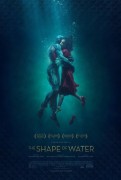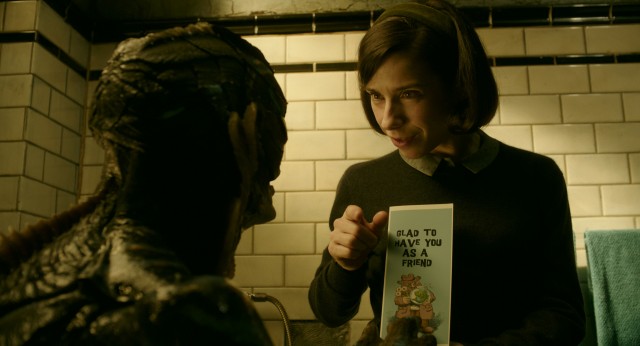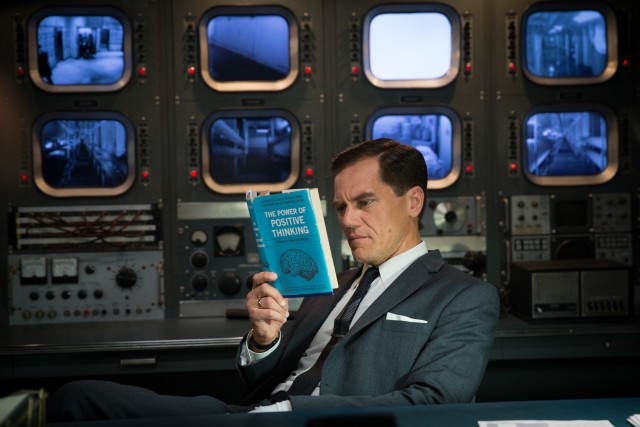The Shape of Water Movie Review
 |
The Shape of Water
Theatrical Release: December 1, 2017 / Running Time: 123 Minutes / Rating: R Director: Guillermo del Toro / Writers: Guillermo del Toro (story & screenplay), Vanessa Taylor (screenplay) Cast: Sally Hawkins (Elisa Esposito), Michael Shannon (Strickland), Richard Jenkins (Giles), Octavia Spencer (Zelda Fuller), Michael Stuhlbarg (Dr. Robert Hoffstetler), Doug Jones (Amphibian Man), David Hewlett (Fleming), Nick Searcy (General Hoyt), Stewart Arnott (Bernard), Nigel Bennett (Mihalkov), Lauren Lee Smith (Elaine Strickland), Martin Roach (Brewster Fuller), Allegra Fulton (Yolanda), John Kapelos (Mr. Arzoumanian), Morgan Kelly (Pie Guy) |
Guillermo del Toro has admirers and more than you might expect when you look at his body of work. In the eleven years since, the two countrymen that with him comprised the so-called "Three Amigos" -- Alfonso Cuaron and Alejandro Gonzalez Inarritu -- have won raves for Gravity, Birdman, and The Revenant. Del Toro's headlines have mostly been news about him signing on and then later dropping out of projects, while also helming a couple of moderately received aspiring blockbusters (Pacific Rim and Crimson Peak) and taking screenplay credits on The Hobbit trilogy and executive producer ones on a number of mid-level DreamWorks animated films.
Del Toro gets his chance to bounce back and catch up with his fellow Amigos in The Shape of Water, his best and most complete film to date. Set in the Baltimore area in 1962, this film centers on a military research facility where Elisa Esposito (Sally Hawkins) works as a custodian. Mute since childhood, Elisa doesn't have many friends or much of a life outside of her work, but she takes some pride in her job, with her co-worker Zelda (Octavia Spencer) looking out for her and making sure she punches in on time.
Elisa and Zelda are asked to clean up after an incident leaves high-ranking security official Strickland (Michael Shannon) with two of his fingers bit off. The women come to learn that the incident involved a remarkable anthropomorphic amphibian (del Toro fixture Doug Jones) that the American military has held in captivity as an "asset" of potentially incalculable value during the Cold War. In time, Elisa bonds with the fish man, who shares her lack of a voice but responds to such stimuli as music and hard-boiled eggs.
When Elisa learns of plans for the military to destroy the asset, she enlists her neighbor and friend Giles (Richard Jenkins), an underemployed print ad artist, to help her arrange for the creature's release.
Shape is the first del Toro film that I've found satisfying as a whole. The director has consistently wowed on a technical level, but his films, even the highly regarded Pan's Labyrinth, have always seemed to place production design above storytelling on a hypothetical priorities list. Like anyone with serious regard for cinema as an art, I appreciate when movies look and sound nice. But technical achievement alone never burrows deep into my consciousness and stays there. Cool visuals and fun design enhances the experience, but if the story and characters do not resonate, the film falls short, leaving you missing something. This is how I've felt about most of del Toro's films, whether the graphic novel-spawned diversion of Hellboy or more artistically ambitious fare. Shape elevates the filmmaker to another level with story and characters of considerable substance.
Shape kind of feels like a modern-day version of a late '50s horror B-movie. You've got the evil military experimenters, the gold-hearted heroine, a tinge of Cold War hysteria (some of it well-founded), and Creature from the Black Lagoon-type sci-fi. It requires an open mind from the viewer, but it rewards such a mindset with something that excites and enchants. The screenplay, which del Toro wrote with Vanessa Taylor (Divergent, Hope Springs, "Game of Thrones"), does not really dabble in shades of gray with its depictions of sexism, homophobia, and xenophobia, but it inspires full sympathy with its life-affirming tale and never suffers from the lack of ambiguity.
This is almost certainly the film that gets del Toro back into the Oscar conversation, after years of even being left out of technical categories. Though the Academy bristles at genre films, this is not exactly Godzilla. The classy stylings and period setting should land the film nominations in Picture, Director, and Original Screenplay. For her mostly sign language performance, Hawkins is a genuine contender for Best Actress, while Jenkins is a safe bet for a well-deserved Supporting Actor nomination, though Shannon could also vie for his third nomination. In addition, married to a resonant story, the usual del Toro technical prowess should manifest in a number of nods in categories like cinematography, production design, hair and make-up, and one or both of the sound categories. The only thing that could stand in the film's way is if it completely fails to find an audience, but with a reported budget of just $20 million, there's virtually no chance this could flop the way that the comparably rich yet much more expensive Blade Runner 2049 did.
|
Related Reviews:
DVDizzy.com | DVD and Blu-ray Reviews | New and Upcoming DVD & Blu-ray Schedule | Upcoming Cover Art | Search This Site
DVDizzy.com Top Stories:
Now in Theaters: Three Billboards Outside Ebbing, Missouri Lady Bird Star Wars: The Last Jedi Wonder Wheel The Man Who Invented Christmas Darkest Hour
Directed by Guillermo del Toro: Crimson Peak Pacific Rim | Written by Guillermo del Toro: Don't Be Afraid of the Dark
Sally Hawkins: Godzilla Blue Jasmine Happy-Go-Lucky Maudie Made in Dagenham | Richard Jenkins: Step Brothers The Hollars Bone Tomahawk
Michael Shannon: Take Shelter 99 Homes Man of Steel Nocturnal Animals | Octavia Spencer: Snowpiercer Gifted The Help Hidden Figures
Text copyright 2017 DVDizzy.com. Images copyright 2017 Fox Searchlight Pictures, Double Dare You Productions. Unauthorized reproduction prohibited.

